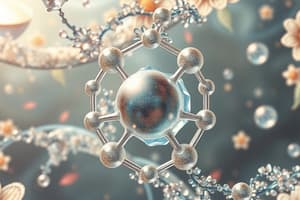Podcast
Questions and Answers
What property of water allows it to dissolve both ionic compounds and other polar molecules?
What property of water allows it to dissolve both ionic compounds and other polar molecules?
- Cohesion
- Low Heat Capacity
- Polarity (correct)
- High Density
How does ice benefit aquatic ecosystems during cold temperatures?
How does ice benefit aquatic ecosystems during cold temperatures?
- By insulating the water beneath it (correct)
- By reducing water volume
- By increasing water temperature
- By promoting chemical reactions
Which property of water helps moderate temperature changes in both the environment and biological systems?
Which property of water helps moderate temperature changes in both the environment and biological systems?
- Low Specific Heat
- High Heat Capacity (correct)
- High Density
- Low Cohesion
What is a direct consequence of water's high cohesion characteristic?
What is a direct consequence of water's high cohesion characteristic?
In which scenario does water act as a universal solvent?
In which scenario does water act as a universal solvent?
What characteristic of water allows it to dissolve a variety of substances?
What characteristic of water allows it to dissolve a variety of substances?
How does water's high heat capacity benefit living organisms?
How does water's high heat capacity benefit living organisms?
What is the primary reason ice floats on water?
What is the primary reason ice floats on water?
What term describes water molecules sticking to one another?
What term describes water molecules sticking to one another?
What effect does adhesion have in plants?
What effect does adhesion have in plants?
What is a consequence of water’s hydrogen bonding?
What is a consequence of water’s hydrogen bonding?
Which property of water is responsible for its ability to absorb and retain heat?
Which property of water is responsible for its ability to absorb and retain heat?
What phenomenon results from water’s cohesion and leads to surface tension?
What phenomenon results from water’s cohesion and leads to surface tension?
What is the pH range for a solution to be considered acidic?
What is the pH range for a solution to be considered acidic?
Which ion demonstrates that a solution is basic?
Which ion demonstrates that a solution is basic?
What occurs during the neutralization of an acid and a base?
What occurs during the neutralization of an acid and a base?
Which property of water is described by molecules sticking to each other?
Which property of water is described by molecules sticking to each other?
What is the normal pH range for human blood?
What is the normal pH range for human blood?
What characteristic of water allows it to dissolve many substances?
What characteristic of water allows it to dissolve many substances?
What effect does the density of ice have on bodies of water?
What effect does the density of ice have on bodies of water?
What term describes the ability of water to rise against gravity in narrow spaces?
What term describes the ability of water to rise against gravity in narrow spaces?
Flashcards
Water's High Heat Capacity
Water's High Heat Capacity
Water resists changes in temperature, helping to regulate Earth's and our bodies' temperatures.
Universal Solvent
Universal Solvent
Water dissolves many substances, making it a key component of life's processes.
Solutions
Solutions
A mixture where one substance (solute) dissolves in another (solvent).
Water's Polarity
Water's Polarity
Signup and view all the flashcards
Water's role in homeostasis
Water's role in homeostasis
Signup and view all the flashcards
Polar molecule
Polar molecule
Signup and view all the flashcards
Hydrogen bond
Hydrogen bond
Signup and view all the flashcards
Cohesion
Cohesion
Signup and view all the flashcards
Adhesion
Adhesion
Signup and view all the flashcards
Surface Tension
Surface Tension
Signup and view all the flashcards
High Heat Capacity
High Heat Capacity
Signup and view all the flashcards
Less Dense as a Solid
Less Dense as a Solid
Signup and view all the flashcards
What is the pH scale?
What is the pH scale?
Signup and view all the flashcards
What makes a solution acidic?
What makes a solution acidic?
Signup and view all the flashcards
What makes a solution basic?
What makes a solution basic?
Signup and view all the flashcards
Neutralization
Neutralization
Signup and view all the flashcards
Blood pH
Blood pH
Signup and view all the flashcards
Buffers
Buffers
Signup and view all the flashcards
How does breathing affect pH?
How does breathing affect pH?
Signup and view all the flashcards
How does urination affect pH?
How does urination affect pH?
Signup and view all the flashcards
Study Notes
Water's Properties
- Earth is approximately 71% water
- Human cells are 60-80% water
- Water is a polar molecule
- Water molecules are held together by hydrogen bonds
Properties of Water
- A water molecule (H₂O) is composed of one oxygen atom and two hydrogen atoms
- Water is polar because oxygen attracts electrons more strongly than hydrogen
Polarity of Water
- Oxygen end has a partial negative charge
- Hydrogen end has a partial positive charge
- This polarity creates hydrogen bonds between water molecules
Hydrogen Bonds
- Weak bonds, but numerous bonds are very strong
- Formed between a very electronegative atom (in a polar molecule) and a hydrogen atom
- Covalent bonds are strong bonds between atoms
Properties of Water Cont.
- Cohesion: Water molecules stick to each other
- Adhesion: Water molecules stick to other substances
- Less dense as a solid: Ice floats on water because ice is less dense than liquid water
- High heat capacity: Water resists temperature changes
- Universal solvent: Water dissolves many substances
Cohesion and Adhesion
- Cohesion describes water molecules attracting each other (e.g., surface tension)
- Adhesion describes water molecules attracting other substances (e.g., capillary action, water moving up plant stems)
Experiments
- Demonstrating cohesion: Count water drops on a penny
- Demonstrating density or surface tension: Place foil or paper clips on water. Observe what happens when foil is pressed. Observe what happens with different materials (e.g., paperclips)
- Demonstrating adhesion: Observe water moving up tubes
Density of Ice
- Ice is less dense than liquid water
- This is unusual and important because it allows ice to float on water, which insulates bodies of water during freezing temperatures
High Heat Capacity
- Water resists large temperature changes
- This helps moderate temperatures on Earth
Universal Solvent
- Water dissolves many substances
- Water is the solvent in many important biological processes (e.g., in living organisms)
Solutions
- Water is typically part of a mixture
- Water is a good solvent, meaning it is the solvent of life
- Solute: The substance that is dissolved in a solution
- Solvent: The substance that dissolves a solute
- Solution = solute + solvent (Example: Iced tea - water is the solvent; tea and sugar are the solutes)
- Water's polarity allows it to dissolve ionic compounds and other polar molecules
- Water is important for reactions like hydrolysis (e.g., macromolecule digestion)
- Experiments: Mixing water, oil, and alcohol to observe solubility
Homeostasis
- Water plays a major role in the regulation of body temperature, and transporting nutrients and wastes
- Water maintains a relatively constant temperature and resists drastic temperature changes, preventing damage to cells
Acids, Bases, and pH
- Water molecules form ions: Hydrogen (H+) and Hydroxide (OH-)
- Acid: A solution with lots of H+ ions (pH 0-7)
- Base: A solution with lots of OH- ions (pH above 7)
- Neutralization: Equal amounts of acid and base of the same concentration results in a neutral pH of 7 (H+ + OH- → H₂O)
- pH scale: Indicates the percent of H+ ions; ranges from 0-14; pH 7 is neutral
- Human blood maintains a pH of 7.35-7.45 (slightly basic)
- Buffers maintain this constant pH
Experiments (pH)
- Use pH test strips to determine the pH of various solutions like water, detergents, coke, vinegar, and hydrogen peroxide
Studying That Suits You
Use AI to generate personalized quizzes and flashcards to suit your learning preferences.




